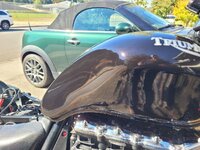Claviger
Aspiring Student
- Joined
- Jul 25, 2014
- Messages
- 6,934
- Location
- Olympia Washington
- Ride
- '21 Z H2, '14 R3R, '02 Daytona 955i
I've ordered a LiPO4 battery, despite my doubts in hope of running a single battery.
IF it works as a single battery and removes the need for 2, it'll be a ~26lb weight reduction, all of it from behind the CG, so will help move bias forward.
Also puts Mufasa at 684lbs wet, fueled, and faired. 678lbs with all the front fairing stuff removed With Jerry on it, bike and rider will be almost the same as a stock Roadster haha.
With Jerry on it, bike and rider will be almost the same as a stock Roadster haha.
I do have a concern about being too light for the Salt, otherwise I'm confident I could get down to 630ish (BSTs, strip ABS gear, single front rotor/caliper, etc etc).
Finally a picture that shows the color of the bike. It's very difficult to photograph.
IF it works as a single battery and removes the need for 2, it'll be a ~26lb weight reduction, all of it from behind the CG, so will help move bias forward.
Also puts Mufasa at 684lbs wet, fueled, and faired. 678lbs with all the front fairing stuff removed
I do have a concern about being too light for the Salt, otherwise I'm confident I could get down to 630ish (BSTs, strip ABS gear, single front rotor/caliper, etc etc).
Finally a picture that shows the color of the bike. It's very difficult to photograph.


